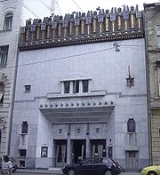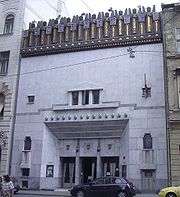
Béla Lajta
Encyclopedia
Béla Lajta (Budapest
, 1873 January 23 – Vienna
, 1920 October 12) was a prominent Hungarian architect.
 Lajta finished his degree at the Budapest Technical University
Lajta finished his degree at the Budapest Technical University
and worked briefly under Alajos Hauszmann
before spending one and a half years in Italy
, mainly Rome
. During that time, he also worked in painting and sculpture. After this he worked in Berlin
and London
. He returned home in 1899 to take part in a competition to design a synagogue
which he won first prize in. His first work in 1900 was the Bard music shop on Kossuth Lajos street, finished in 1900. Ödön Lechner
was a notable influence on him at this time. They worked together on a number of projects, namely the Kozma Street Cemetery
's Schmidl crypt. He designed a number of buildings in the Hungarian offshoot style of Art Nouveau
, called szecesszió in Hungarian, the most notable being Rózsavölgyi house in Budapest on Szervita square.
In 1909 he designed, in an Art Deco
style the Parisiana, Paulay Ede utca, Budapest, now New Theatre (Új színház).
After a serious illness he died at a comparatively young age.
Budapest
Budapest is the capital of Hungary. As the largest city of Hungary, it is the country's principal political, cultural, commercial, industrial, and transportation centre. In 2011, Budapest had 1,733,685 inhabitants, down from its 1989 peak of 2,113,645 due to suburbanization. The Budapest Commuter...
, 1873 January 23 – Vienna
Vienna
Vienna is the capital and largest city of the Republic of Austria and one of the nine states of Austria. Vienna is Austria's primary city, with a population of about 1.723 million , and is by far the largest city in Austria, as well as its cultural, economic, and political centre...
, 1920 October 12) was a prominent Hungarian architect.
Career

Budapest University of Technology and Economics
The Budapest University of Technology and Economics , in hungarian abbreviated as BME, English official abbreviation BUTE, is the most significant University of Technology in Hungary and is also one of the oldest Institutes of Technology in the world, having been founded in 1782.-History:BME is...
and worked briefly under Alajos Hauszmann
Alajos Hauszmann
Hauszmann Alajos was an Austro-Hungarian architect, professor, and member of the Hungarian Academy of Sciences.-Life:...
before spending one and a half years in Italy
Italy
Italy , officially the Italian Republic languages]] under the European Charter for Regional or Minority Languages. In each of these, Italy's official name is as follows:;;;;;;;;), is a unitary parliamentary republic in South-Central Europe. To the north it borders France, Switzerland, Austria and...
, mainly Rome
Rome
Rome is the capital of Italy and the country's largest and most populated city and comune, with over 2.7 million residents in . The city is located in the central-western portion of the Italian Peninsula, on the Tiber River within the Lazio region of Italy.Rome's history spans two and a half...
. During that time, he also worked in painting and sculpture. After this he worked in Berlin
Berlin
Berlin is the capital city of Germany and is one of the 16 states of Germany. With a population of 3.45 million people, Berlin is Germany's largest city. It is the second most populous city proper and the seventh most populous urban area in the European Union...
and London
London
London is the capital city of :England and the :United Kingdom, the largest metropolitan area in the United Kingdom, and the largest urban zone in the European Union by most measures. Located on the River Thames, London has been a major settlement for two millennia, its history going back to its...
. He returned home in 1899 to take part in a competition to design a synagogue
Synagogue
A synagogue is a Jewish house of prayer. This use of the Greek term synagogue originates in the Septuagint where it sometimes translates the Hebrew word for assembly, kahal...
which he won first prize in. His first work in 1900 was the Bard music shop on Kossuth Lajos street, finished in 1900. Ödön Lechner
Ödön Lechner
Ödön Lechner was a Hungarian architect, nicknamed the "Hungarian Gaudí".Lechner was one of the early representatives of the Hungarian Secession movement, called szecesszió in Hungarian, which was related to Art Nouveau and Jugendstil in the rest of Europe...
was a notable influence on him at this time. They worked together on a number of projects, namely the Kozma Street Cemetery
Kozma Street Cemetery
The Kozma Street Cemetery is the biggest Jewish cemetery of Budapest, Hungary. It is located next to the New Public Cemetery .- Jewish cemetery :...
's Schmidl crypt. He designed a number of buildings in the Hungarian offshoot style of Art Nouveau
Art Nouveau
Art Nouveau is an international philosophy and style of art, architecture and applied art—especially the decorative arts—that were most popular during 1890–1910. The name "Art Nouveau" is French for "new art"...
, called szecesszió in Hungarian, the most notable being Rózsavölgyi house in Budapest on Szervita square.
In 1909 he designed, in an Art Deco
Art Deco
Art deco , or deco, is an eclectic artistic and design style that began in Paris in the 1920s and flourished internationally throughout the 1930s, into the World War II era. The style influenced all areas of design, including architecture and interior design, industrial design, fashion and...
style the Parisiana, Paulay Ede utca, Budapest, now New Theatre (Új színház).
After a serious illness he died at a comparatively young age.

